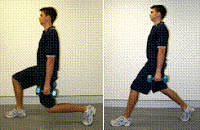Want to begin a strengthening program and tone up but don't have much time to spare!
Here’s where to begin…
Consult your Doctor
Before beginning an exercise program, it is important that you are medically clear to do so. Getting medical clearance from a doctor can give you peace of mind to commit yourself fully to your exercise program.
Benefits of Resistance Training
As we get older our muscle mass reduces with inactivity. Given that muscle is a highly active tissue that burns a lot of energy, a reduction often leads to weight gain. This makes resistance training imperative to curb the decline and possibly restore muscle mass/tone. The age old adage still applies - If you don't use it, you’ll lose it!
Some other benefits are as follows;
· Increased muscle strength, power, endurance and size, depending on your training approach
· Increased bone density and strength resulting in a reduced risk of osteoporosis
· Reduced body fat and improved weight control
· Lowered Heart Rate and Blood Pressure after exercise and increased HDL (good) cholesterol (associated with lower heart disease risk)
· Reduced risk for Heart Disease, Diabetes & Arthritis
· Improved sense of wellbeing
Myths about Resistance Training
There are a lot of misconceptions in the market about resistance training. Many people, especially women, avoid lifting weights from fear of looking like an elite body builder—This only happens with very intense training regimens and most women lack the testosterone to develop significant muscle bulk. Toned arms and legs are likely to be a more common outcome.
Basic Principles of Strength Training
These involve the manipulation of a number of variables to cause changes in muscle strength, endurance or size by overloading the muscles. The variables include:
Repetitions (Reps)- A single cycle of lifting and lowering a weight
Sets– A group of repetitions performed without a break
Exercise– Different exercises to activate specific muscle combinations
Speed/Tempo— The rate to lift and lower the weight
Progressive Overload—When you can comfortably do all the prescribed repetitions in one exercise, gradually increase the weight
Rest and Recovery—To allow time for your muscles to recover, rest between sets and allow one full day before exercising the muscle group again in a new session
Exercise Options
· Body Weight— Using your own body as resistance. For example, push ups, pull ups and abdominal crunches.
· Resistance Tubing—A lightweight tubing that provides resistance when stretched
· Free Weights— Using barbells or dumbbells
· Weight Machines—Found in fitness centers or can be purchased for home use
Safety Considerations
· Don’t forget to breathe. Exhale at the point of greatest exertion during the lift
· Make sure you are using the correct lifting technique. You could use a mirror or consult with an Exercise Physiologist.
What is Recommended for Strength Development in Beginners?
· Train on 2-3 days per week
· Choose exercises involving the major muscle groups
· Complete each exercise by performing 8-12 repetitions over 1-3 sets
· The load should be adequate in order for the muscles to be fatigued. Choose a weight where the desired number of repetitions can only just be achieved
· Lift weight at a slow to moderate speed
· Consult an Exercise Physiologist for training suggestions on a program to maximize muscle strength, growth, endurance or power
Sample Program
Curl Up: Uses: Abdominal muscles
 Lie on the floor (or mat) on your back. Your knees should be bent and one foot flat on the floor and the other straight.
Lie on the floor (or mat) on your back. Your knees should be bent and one foot flat on the floor and the other straight.
 Lie on the floor (or mat) on your back. Your knees should be bent and one foot flat on the floor and the other straight.
Lie on the floor (or mat) on your back. Your knees should be bent and one foot flat on the floor and the other straight. Place your hands behind your head. While exhaling lift your shoulder blades off the floor.
Hold for 2 seconds, slowly inhale and lower back to floor.
Do not use your hands and arms to help lift you up– use abdominals and hips.
Push ups: Uses Chest, Triceps and Shoulders
Lie face down with your hands at shoulder height, palms flat on the floor and a little more than shoulder-width apart.
Straighten your arms as you push your body up off the floor.
Keep your back straight and bottom down.
Then lower the body to the floor, bending the arms and keeping the body straight.
Alternatively, these can be done on your knees or with your hands against a wall or bench.
Bent over Row: Uses– Back Muscles
Tip your body slightly forward at the hips, keeping your back straight and shoulders back.
Hold DB’s with hands shoulder width apart and facing thighs.
Bend elbows to lift DB’s towards your stomach/rib cage.
Squeeze between your shoulder-blades throughout this movement, particularly at the top. Keep your shoulders down and back.
Lunges: Uses: Buttocks and Thigh muscles
Place one foot out in front – with body weight on heel. Raise the back foot up onto your toes. Keep both feet parallel.
Stand up straight, and keep your bottom tucked in.
Lower your body by dropping your back knee down to floor, don’t move forward, just down.
Watch that your front knee doesn’t move too far forward. Both legs should form 90deg angles at bottom or movement. Raise body up using thighs and gluteals, pushing through the heel.
You can add extra weight by holding dumbbells.
Resources:
· American College of Sports Medicine (ACSM):
· Better Health Channel—Www.betterhealth.vic.gov.au
· Spark People— http://www.sparkpeople.com
· Find your 30—http://www.your30.qld.gov.au/
Disclaimer
This Fact Sheet is provided for your information only and does not replace qualified medical advice. The information provided may not apply to every person or all situations. A medical practitioner should be consulted for all treatment and medication.




No comments:
Post a Comment